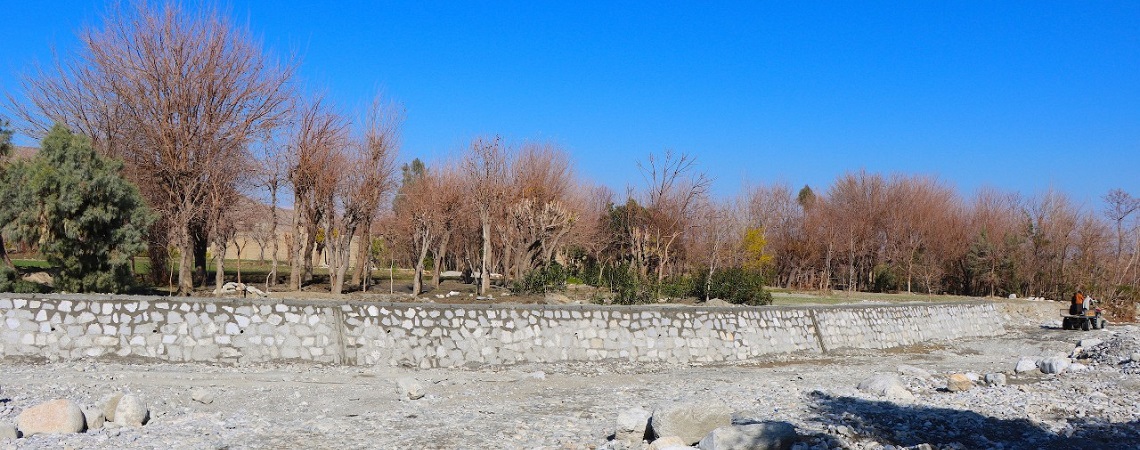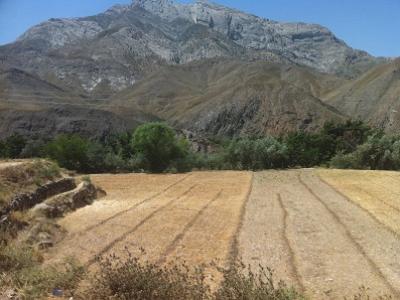
The project 'Adapting Afghan Communities to Climate-Induced Disaster Risks' will improve the preparedness and resilience of select Afghan communities to climate-induced disaster risks. The five-year project (2017-2022) will improve decisions and implementation of climate-induced disaster risk measures, deploy and effectively utilize community-based early warning systems, support climate-resilient livelihood strategies in targeted community, and strengthen institutional capacities to integrate climate risks and opportunities into national and provincial plans, budgets and policies.
The project aims to achieve the following:
- 2 provinces have climate action plans and early warning/data information management systems
- 25,000 people reached through public awareness activities
- 200 people htrained on monitoring, tracking and analysis of weather data and hazard mapping (including 20% women)
- 30 community-level hazard mapping and vulnerability assessments carried out or updated
- 30 communities provided with improved climate-related early warning information
- Quarterly tests conducted of early warning communication procedures in 60 communities
- 30 gender-sensitive, community-specific climate-induced DRR plansormulated and approved by CDCs and tested through emergency drills
- 20 habitats, multi- purpose emergency shelters or small-scale rural infrastructure built, reinforced or incorporated new materials for enhanced climate resilience
- 1,000 beneficiaries benefit from the adoption of diversified, climate-resilient livelihood options (including 30% women and 40 kuchi)
- 2 Provincial Climate Action Plans and 60 Community Development Plans are developed and strengthened to identify, prioritise and integrate adaptation strategies and measures including implementation budgets
- 160 staff are trained to identify, prioritise, implement, monitor and evaluate adaptation strategies and measures (including 20% women)
- 4 lessons learned/best practices are shared through regional processes such as the Heart of Asia – Istanbul Processes
- National
- United Nations Development Programme (UNDP)
- Global Environment Facility (GEF)
- United Nations Development Programme (UNDP)
Expected outcomes
Outcome 1: Decision-making and implementation of climate induced disaster risks reduction measures are improved in selected communities, through enhanced capacities
Outcome 2: Community-based early warning systems in place and effectively utilized
Outcome 3: Climate-resilient livelihoods are implemented in targeted communities
Outcome 4: Strengthened institutional capacities to integrate climate risks and opportunities into national and provincial development plans, policies, budgetary allocation and implementation mechanisms
As the variability and intensity of extre me weather effects , including floodi ng and landslides (rapid onset) and drought (slow onset) increases, the efforts to manage and respond to climate change induced risks in Afghanistan is significantly challenged. According to the National Adaptation Progr amme of Action (NAPA) , these key climate change hazards in Afghanistan present a threat to ecosystem services and livelihoods. The most vulnerable economic sectors are water and agriculture. In 2012, 383 natural disaster incidents were recorded in 195 dist ricts that resulted in 4,790 deaths, affected 258,364 people and damaged or destroyed 29,374 homes (OCHA, 2012). Most recently, torrential rains in April 2014 led to flash floods, affecting 27 districts in western, northern, and north- eastern provinces, ki lling more than 150 people, affecting 67,000 and displacing 16,000. In May 2014, thousands of people were seriously affected during a mudslide triggered by heavy rains, in Argo District, Badakshan. In addition to loss of lives, climatic hazards also caused extensive damage to assets and property worth millions of dollars. According to a UNISDR report, 80% of the economic loss is due to climate induced disasters caused by floods, drought and extreme winters
The Government of Afghanistan’s long-term preferred solution to this worsening problem is to establish efficient and effective mechanisms by which vulnerable communities are better equipped to anticipate and respond to climate change-induced risks. However, the preferred solution is hindered by several political, socio-economic, and institutional barriers, at both the national and sub-national level. In particular, an efficient response to reduce the country’s vulnerability to climate-induced disaster risks is constrained, among others, by:
• Insufficient data and limited understanding of climate change-induced disaster threats. Across institutions at the national and sub-national levels, there is insufficient understanding of the likely impacts of climate change effects and intensity of climate change-induced disasters. At the community level, there is also limited awareness and ineffective communication on disaster preparedness and the linkages with climate change. There is an absence of centralized data management system for climate change induced disasters and disaster management and an absence of effective monitoring and evaluation mechanism to track impacts of interventions. Further, there is limited research on the gaps in contingency plans and emergency preparedness and response at village and district levels. Gender sensitive data is missing in the country, which constrains the formulation of adequately targeted responses.
• Policies and regulations do not efficiently link climate change, disaster occurrence and risks and development planning : There is an overall absence of adequate policies and regulations on climate adaptation in the context of disaster risk management. Inadequate enforcement of existing relevant policies, plans and programmes including National Priority Programs (NPPs) as well as the obligations under the Hyogo Framework for Action (HFA) and United Nations Framework Convention on Climate Change (UNFCCC), is also observed.
• Insufficient institutional coordination to manage and respond to disasters: The limited coordination between different governmental agencies, as well as between government and international organizations and non-governmental organizations, hinders the management of disasters at the provincial, district and village levels. Community Based Organizations (CBOs) who are capacitated in disaster response are limited in number and resources, making it difficult for authorities to collect data and information and respond to emergency situations in a comprehensive manner. An effective and functional institutional organizational framework for key stakeholders to implement coordinated action on climate change and DRM is missing. The main government agency tasked with DRM coordination, ANDMA lacks substantive capacity to strategically assess disasters that are linked to climate change and those that are not.
• Inadequate engagement of women in disaster risk reduction activities: Women lack capital, networks and influence and have little access and control over land and economic resources that are vital in disaster preparedness, mitigation, and recovery. Unbalanced gender norms affect women’s access to assistance from climate induced disasters. Low literacy level and status of women hinders their empowerment to act as promoters of resilience in the communities.
Outcome 1: Decision-making and implementation of climat induced disaster risks reduction measures are improved in selected communities, through enhanced capacities
Resources will be used to raise awareness and increase understanding at the community level on the importance of integrating accurate climate information into DRM efforts, and development planning. The project will build the capacities of the communities and Community Development Councils (CDCs) and the local extension offices of MRRD and MAIL in systematically collecting, monitoring, tracking, and analyzing climate data for adequate preparedness and risk reduction.
Communities will be the key actors and decision-makers in a participatory situational analysis to ensure successful mapping, analysis and effectiveness of the adaptation interventions. Given the low technical capacities and the current state of extension offices facilities it has been noted that the technologies procured for this effect should be user-friendly and easy-to-install and maintain (upstream and downstream gauges, rain gauges, staff gauges, etc). Hazard maps and vulnerability and risk assessments will then be produced by capacitated community councils in collaboration with extension officers and national officers of MRRD and MAIL, so they may further replicate this activity in other provinces.
Outcome 2: Community-based early warning systems in place and effectively utilized
A community-based approach to EWS is proposed recognizing that the first response to a disaster always comes from the community itself. In order to pilot effective CBEWS in the selected provinces, this outcome will focus in delivering timely information in order to lessen the negative impacts of weather-induced disaster. The CBEWS will ensure that all community members’ needs, especially the most vulnerable (women, children, people with disabilities) are considered. In order to do this, the proposal will aim to achieve three main inter-related interventions: i) Ensure that there is a mechanism through which climate hazards can be monitored 24/7 , including adequate calculation of lead time and threshold values on which warning and alert levels will be based; ii) Coordinate warning services with relevant stakeholders (extended offices of MAIL and ANDMA) and enable efficient warning dissemination channels using multiple communication channels (mobile phones, sirens, loudspeakers on mosques, TVs and megaphones); iii) Strengthen response capabilities of the communities. It will be essential to define clear roles and responsibilities of the community and plan and allocate human resources. Contingency plans (addressing evacuation, first aid, health, shelter, water and sanitation, and rescue issues) to reduce impact of disaster will be designed in partnership with active NGOs, UN Agencies and other actors.
Outcome 3: Climate-resilient livelihoods are implemented in targeted communities
Resources will be used to complement improved preparedness with more resilient physical assets and income-generating opportunities for community beneficiaries. Based on appropriate vulnerability assessments and hazard maps completed under Outcome 1.1, MRRD will support CBOs and community authorities to design, assess (through appropriate feasibility studies) and build climate-proofed habitats and emergency shelters. Households will be better equipped to endure harsh weather conditions (heat or cold), as well as be less susceptible to damages from intense flooding, rains, and/or landslides. Climate-resilient emergency shelters will be multi-functional to serve as temporary education facilities, community meeting places, emergency supply storage, and/or primary health care. These infrastructures would also support home-based economic activities such as storage of food and agro-products, processing and canning. Secondly, location-specific risk planning and land zoning will help identify suitable areas for these infrastructures as well as other land uses such as crop culture, agroforestry, forestry and horticulture. Micro-enterprise development with a specific focus on women and youth will help communities capitalize on these new opportunities by incorporating improved disaster preparedness and CBEWS set up in Outcome 2.1.
These efforts will ultimately help increase savings and enhance food security at the community level, reducing the vulnerability of these communities to climate-induced disasters. Livelihood interventions will be identified during PPG phase to ensure tailored design that engages the most vulnerable. A robust market survey will be conducted to ensure that income-generating activities have a real market demand.
Outcome 4: Strengthened institutional capacities to integrate climate risks and opportunities into national and provincial development plans, policies, budgetary allocation and implementation mechanisms
In order to address the limited understanding of the implications of climate change in disaster risk and in development, this project will provide capacity-building to key government actors, to increase institutional coordination and synergies on climate change adaptation efforts. LDCF resources will be used to strengthen technical capacities within the Climate Change Department within NEPA on climate change policy, adaptation, and linkages between CCA, DRM, and development, at the national level. This is critical to ensure that national climate change policies and strategies are adequate and that the Department is able to promote, across ministries, the importance of incorporating climate risks into longer-term development planning.
This Outcome aims to support the Government of Afghanistan in kick-starting the National Adaptation Plan (NAP) process to establish a mechanism whereby medium and long-term development planning and budgeting takes into account climate risks. This is particularly important when planning for DRM/DRR efforts, and in the case of Afghanistan, it is vital to sustain any development interventions.


